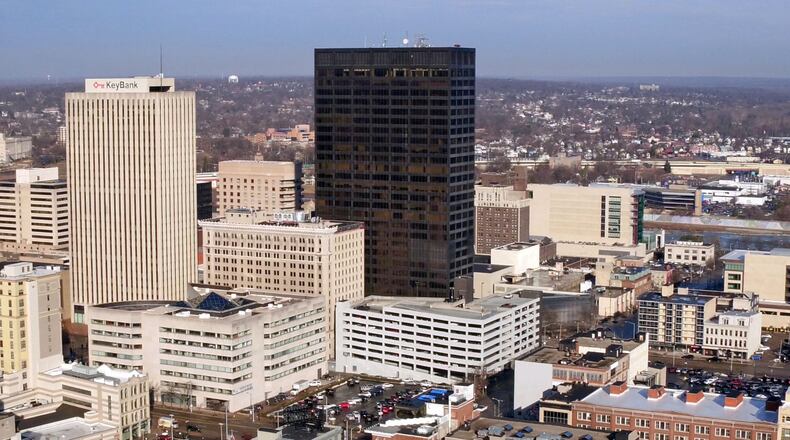An additional $10 million will be invested in the 10 N. Ludlow St. Courthouse Plaza building the company bought in December.
Those downtown buildings will anchor a growing global digital technology business aiming for $5 billion in sales worldwide by 2025.
“We have 30 offices all around the world,” Riegel said at a press conference Wednesday morning at the Dayton Club, atop the tower. “What we see ... is building an ecosystem for the right environment for smart people to be successful.
“We believe these buildings in the city are key to that new growth,” he added.
Over the next 18 to 24 months, Stratacache will make the re-branded Stratacache Tower its headquarters, leaving current offices at 2 Emmett St.
The company will occupy three to four floors of the tower, creating a customer technology experience center in one of the floors, Riegel said.
And the CEO pointed to still-tentative retail and restaurant plans for the Tower’s lobby and first floor.
The plan as outlined by Riegel Wednesday: Move 150 current Dayton jobs into the two recently purchased downtown buildings, then add “at least” 300 technology and engineering jobs with average salaries of about $100,000 annually.
Stratacache intends to invest in four key areas: Advanced software for digital displays, next-generation digital signage, artificial intelligence and “deep computer learning,” and consumer insights/smart sensor platforms.
“We’re building the systems for leading companies around the world that help them deliver on that next-generation experience in a retail store, in an airport, in a stadium,” Riegel said.
That tech will be born in Dayton, he said.
Ohio Lt. Gov. Jon Husted, who hails from the Miami Valley, said the announcement goes well beyond one company’s expansion.
Young people and families will take notice, Husted said. “You can work for a global company right here in Dayton.”
Phil Parker, president and CEO of the Dayton Area Chamber of Commerce, said it’s a “strategic disadvantage” for cities to have outside owners owning “iconic buildings” like the former Kettering Tower.
Local ownership alters that for the better, Parker said.
“Chris, thank you for the commitment,” he told Riegel.
Dayton Mayor Nan Whaley said private-sector partnerships, such as the one between Dayton and Stratacache, help Dayton “punch above its weight.”
Traditionally, the company has not availed itself of government development incentives. Riegel said this time, he is open to having a “dialogue” with the state and localities on that subject.
But he also said: “This growth is not based on government subsidy or incentives. It’s based on Dayton being a great place to do business. All the right conditions are here in this region to be a world-class tech business.”
The CEO has cited the need for the “best and the brightest employees” as one reason for the purchase of Kettering Tower.
Sometimes, companies showing the same desire for younger workers move south of Dayton — to Austin Landing, for example.
Stratacache is doing the opposite, investing in Dayton’s central business district. That’s no accident, Riegel said in an interview Tuesday.
Young people “increasingly like living in cities as opposed to suburbs,” he said. “I get that Austin Landing five years ago, seven years ago, was cool, but … the trend is very specifically snapping back to cities.”
“You’ve seen a brain drain from Dayton — NCR, Teradata, others that have left the region,” he also said. “In any tech business, the key point is attracting talent, the key point is to make an opportunity for people to be able to be successful in what they’re going to do with their lives and their careers.”
Stratacache is in the business of creating striking digital displays. Asked about the possibility of creating a visual statement at Kettering Tower, Riegel said that’s something the company will consider, but zoning laws and aircraft flight patterns toward Wright-Patterson Air Force Base need to taken into account.
“We’re absolutely looking at those options,” he said in his earlier interview.
About the Author

